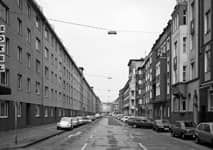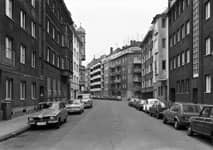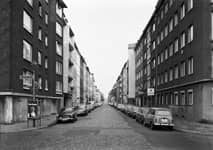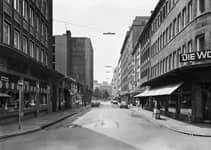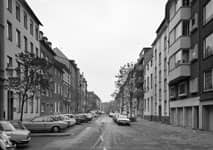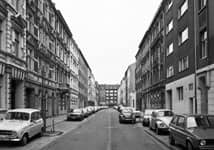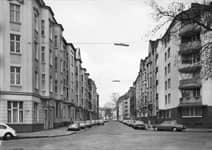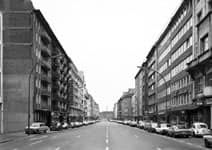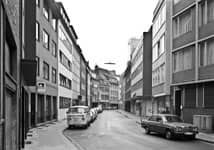Each year, students at the Kunstakademie Düsseldorf presented a body of new work in an exhibition called the Rundgang. For the exhibition in February 1976, Struth decided to shift the focus of the photographic work and concentrate on the street itself rather than the figure within an urban context. He made a grid comprising forty-nine photographs of streets in Düsseldorf, seven by seven, each photograph structured around a central perspective.
Struth photographed streets all over Düsseldorf, working on weekends and always with the camera placed on a tripod in the middle of the street. It was important to Struth that the photographs were a systematic documentation of ordinary streets in an unremarkable, reconstructed German city rather than the result of personal selection.
Struth’s knowledge of photography at this stage was limited to books, magazines and occasional encounters in museums with the work of artists using the photographic medium. For the most part, however, these artists renounced traditional pictorial qualities and used the medium in a casual, informal or amateurish way, such as Ed Ruscha’s books or Christian Boltanski’s collections of apparently archival material.
On occasion Struth was asked by Gerhard Richter to work in his studio, for example to assist in the preparation for a presentation of Atlas at the Museum Haus Lange in Krefeld.
Struth remembers “piles of cheap photographic prints in the studio, which I glued on cardboard to be framed, piles of images of seascapes, flowers, icebergs. It was an important encounter with a certain kind of conceptual thinking.” At the same time Struth was also collecting postcards, for example of Cologne Cathedral, analysing the variations in different postcards of the same view—the colour, the clouds, the different camera positions.
For Struth, the encounter with Becher and his wife Hilla was liberating. “Their class offered a different kind of laboratory of thinking. With Richter the discussion was specialised, centred on the history of painting and related to his own practice. The Bechers were open and discursive. They encouraged a wide-ranging reflection extending from the practice of photography out into the world. By the very nature of photography, the choice of subject is always related to other issues. The Bechers made connections between different fields—literature, politics, economics, painting and film; between Proust and Atget, for example, or the technical development of the blast furnace and its social and historical contexts.”




